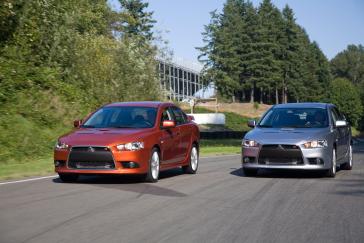The 2009 Mitsubishi Lancer Ralliart is engineered to provide an exhilarating driving experience, with agile, responsive handling that does not force the driver to sacrifice everyday driving comfort. The basis for Lancer Ralliart's engaging, fun-driving character is a global performance-engineered platform optimized from the beginning to handle high levels of power, and the high levels of grip made possible by Mitsubishi's advanced 4WD systems. This platform was introduced first for the 2007 Outlander SUV, a vehicle that provides uncommonly energetic driving responses for its segment.
An advanced All-Wheel Control system with Active Center Differential (ACD) works in concert with Ralliart-tuned chassis to make the Lancer Ralliart an aggressive twisty-road tamer. (See separate release for Lancer Ralliart All-Wheel Control.) Standard 10-spoke 18-inch alloy wheels with 215/45 R18 Yokohama ADVAN summer tires and large 4-wheel disc brakes give the Lancer Ralliart outstanding grip and stopping performance. The standard anti-lock braking system (ABS) incorporates Electronic Brake-force Distribution (EBD).
Safety-Optimized RISE Body Structure
The Lancer models are built around Mitsubishi's next-generation Reinforced Impact Safety Evolution (RISE) unibody design. The highly rigid structure makes extensive use of ultra-high-tension steel, a material that was not used in the previous-generation Lancer. A stiff body structure can allow sport suspension tuning without compromising a compliant ride.
Compared to the previous-generation Lancer, torsional rigidity is increased by 56 percent, and bending rigidity is up by 50 percent. These increases in both torsional and bending rigidity exceed body stiffness measurements of even the previous-generation Lancer Evolution (Lancer Evolution IX in other markets.)
Straight front side members with an octagonal cross-section and a three-leg support structure, as well as application high-strength steel, are designed to help Lancer models meet the highest crash test standards. The side pillars, roof joints and cross-car structure - combined with the standard front seat-mounted side air bags, driver knee air bag and standard front and rear curtain side air bags - give the new Lancer a higher degree of collision protection.
Rigidity Throughout
The lower body structure, where the suspension attaches to the car, also demonstrates the benefits of higher rigidity. Here, one can appreciate the holistic approach engineers used to achieve this goal. As one example, the Lancer's new-generation engines use a rear-mounted exhaust manifold, as opposed to the front-mounted exhaust manifold on the previous-generation Lancer engines. That change allowed use of a flat front suspension crossmember, where the previous model required a saddle-shaped crossmember to provide clearance for the exhaust pipe. A flat front crossmember can directly receive lateral loads from the front lower arms.
Strut tower, side and lower braces enhance lateral rigidity for precise steering response, and lower control arm attachment points and steering knuckles are strengthened. The combination of these enhancements, along with retuned lower control arm bushings, contribute to quicker steering response in the new-generation Lancer models.
Redesigned Front Suspension
The MacPherson strut front suspension is the same as used in the Lancer GTS, but with specific tuning for the Ralliart 4WD application, including higher spring and damper rates. The Lancer Ralliart employs a 22-mm front stabilizer bar (vs. 21 mm for Lancer GTS and 25 mm for Lancer Evolution) and higher spring and damper rates. The stabilizer strut helps ensure optimal roll rigidity and improved steering stability.
Multi-link Rear Suspension
The Lancer Ralliart is equipped with its own version of the trailing-arm type multi-link rear suspension used on other Lancer models, featuring specific cast trailing arms.
The Lancer Ralliart features the same 20-mm (0.79-in.) rear stabilizer bar as the Lancer GTS (vs. 23 mm for Lancer Evolution) but features higher-rate springs and dampers. Ball joint-type stabilizer links and a hub unit bearing provide high camber and toe rigidity.
Crisp, Responsive Steering
The Lancer Ralliart shares the same basic steering system as the Lancer GTS, with minor differences in pump specifications that create a sensation of steering speed and response that is between Lancer GTS and Lancer Evolution. The hydraulic system is optimized for greater efficiency, reliability and reduced pump noise. A variable-flow pump contributes to fuel efficiency. The optimized steering column layout features joint friction-reduction parts that improve steering feel (reduced torque fluctuation). Dampers used on the intermediate shaft help reduce shimmy. The smaller diameter Lancer Ralliart steering wheel, borrowed from the Evolution also contributes to a feeling of faster steering response.
Confident Braking Performance
The 2009 Lancer Ralliart not only tames curves, but does so with the confident stopping power of the same brakes as the larger, heavier Outlander SUV -- 11.6-in. (294 mm) vented discs in front and 11.9-in. (302 mm) solid discs in rear. This is essentially the same brake system used on the Lancer GTS, the differences being dual-piston calipers on the front brakes in the Ralliart, vs. single-piston on the GTS, and slightly larger-diameter pistons for the single-piston rear brakes. Front rotors on both models measure 1.0 in. thick, and the rear rotors are 0.4 in. thick. Both use high-friction coefficient pads to improve performance. The single 10-in. brake vacuum booster, with a long-stroke master cylinder, optimize boost power and brake feel. The standard anti-lock braking system (ABS) incorporates Electronic Brake-force Distribution (EBD).
Lancer Ralliart Warranty
Lancer Ralliart is covered by a bumper-to-bumper, New Vehicle Limited Warranty of 36 months or 36,000 miles (whichever comes first). The restraints system and the highly technical powertrain are covered by a 5-year or 60,000 miles Powertrain Limited Warranty, an Anti-Corrosion Perforation Limited Warranty for 7-years or 100,000 miles and a generous 5-year, unlimited miles timeframe for roadside assistance. All warranties are transferable to subsequent owners; coverage time begins on the original in-service date (does not start over with resale.)













































































